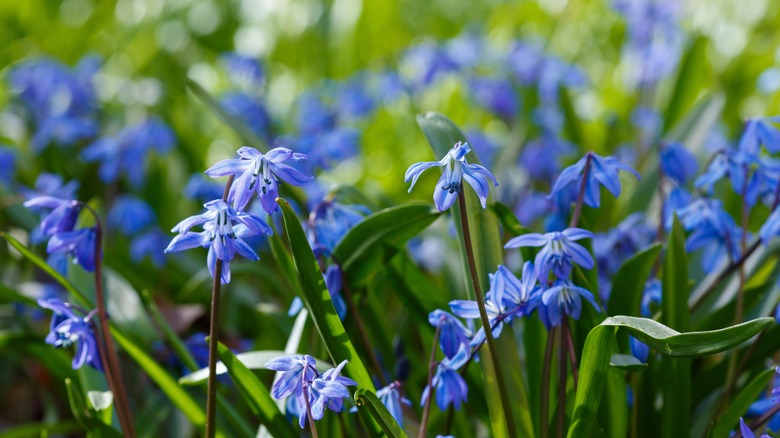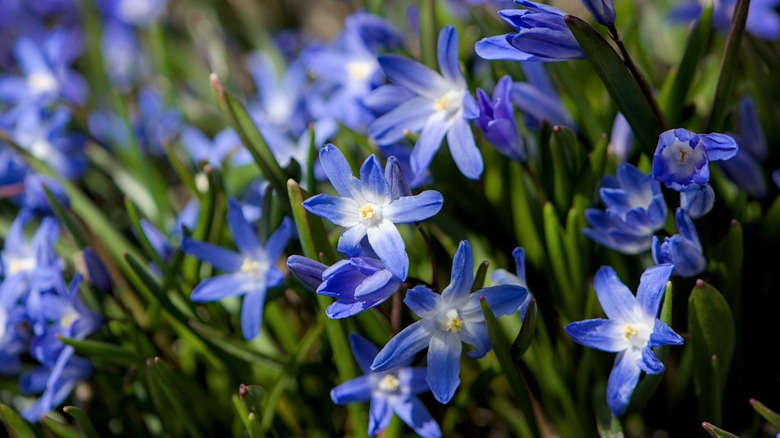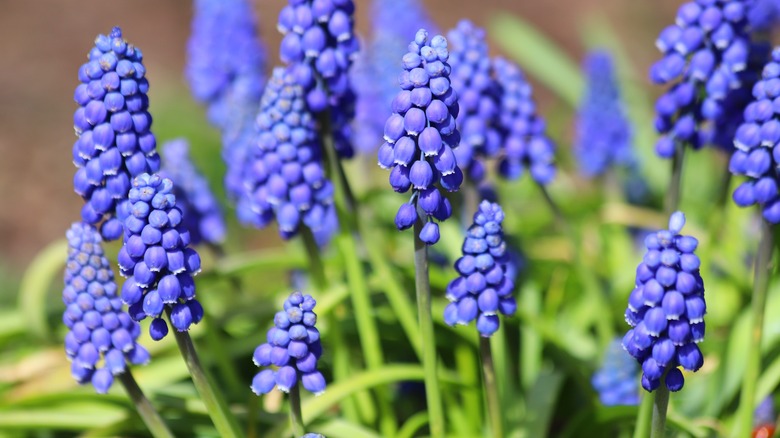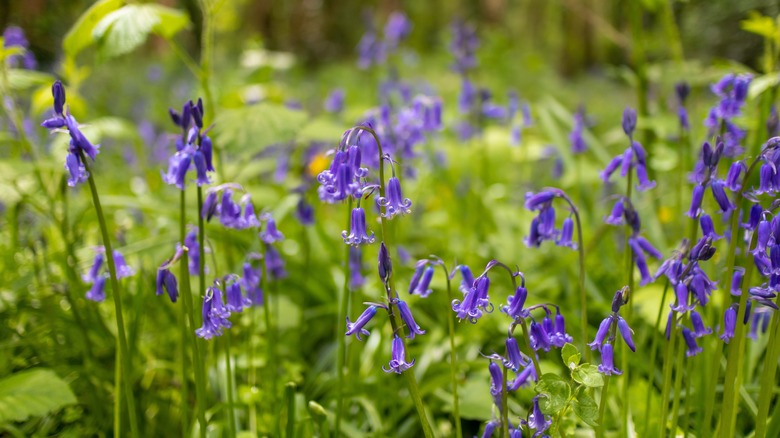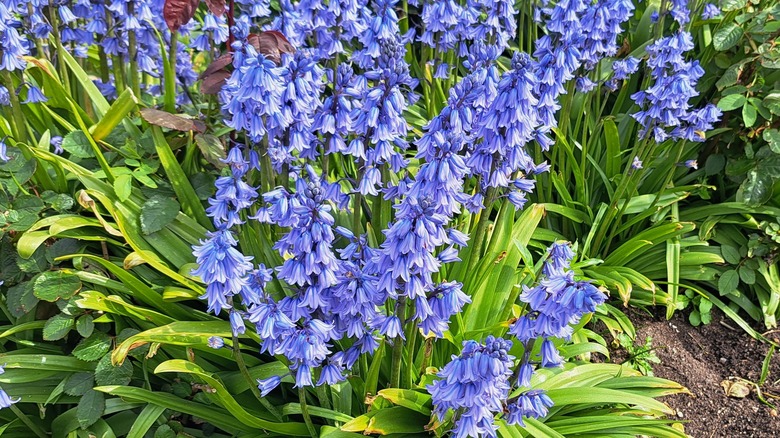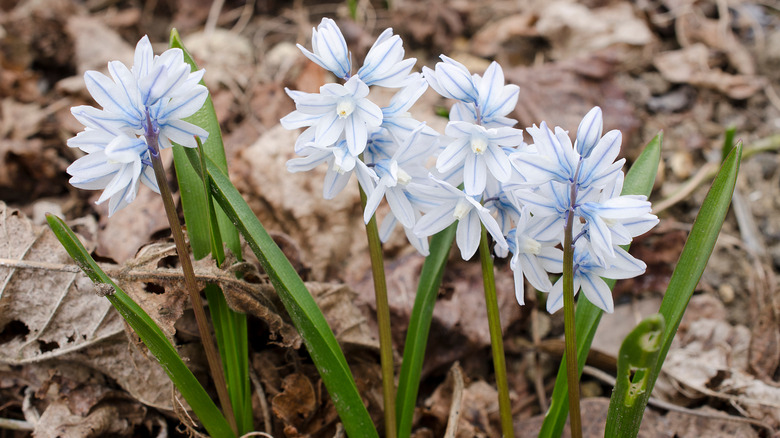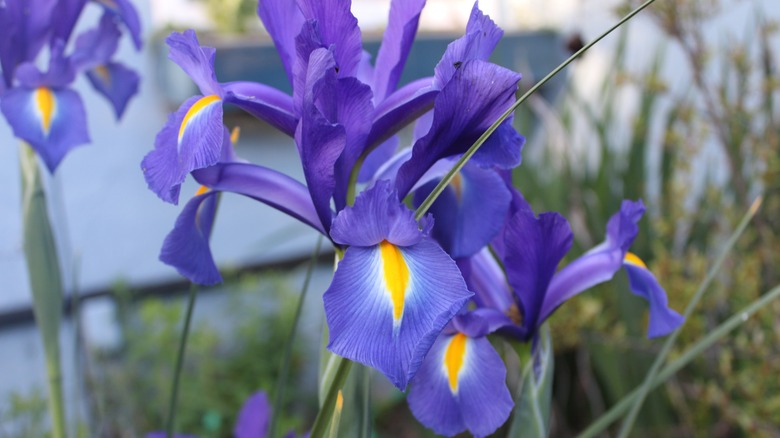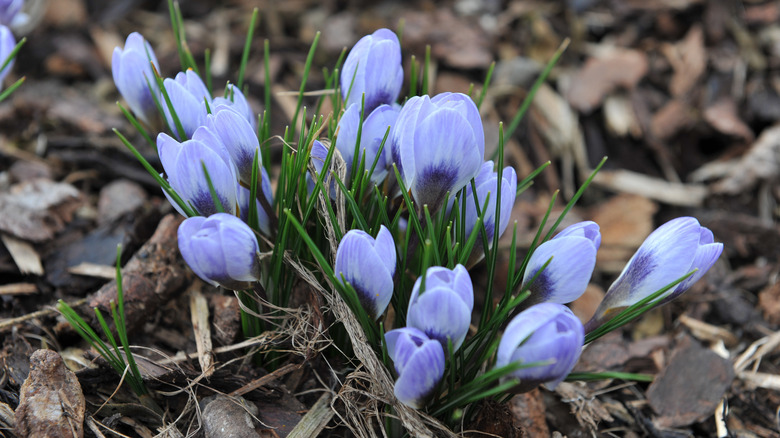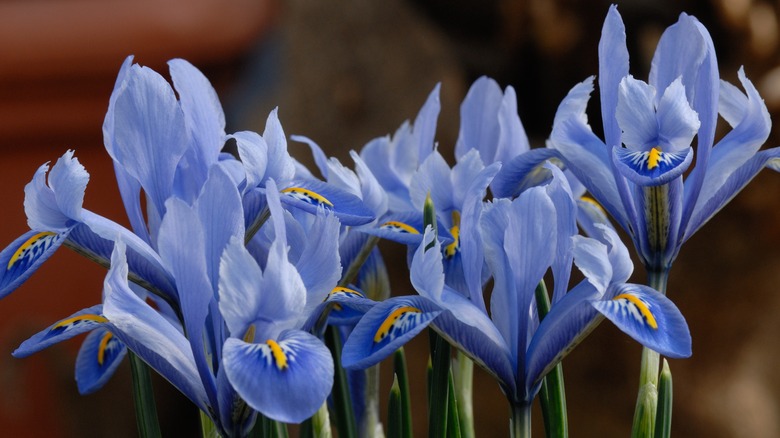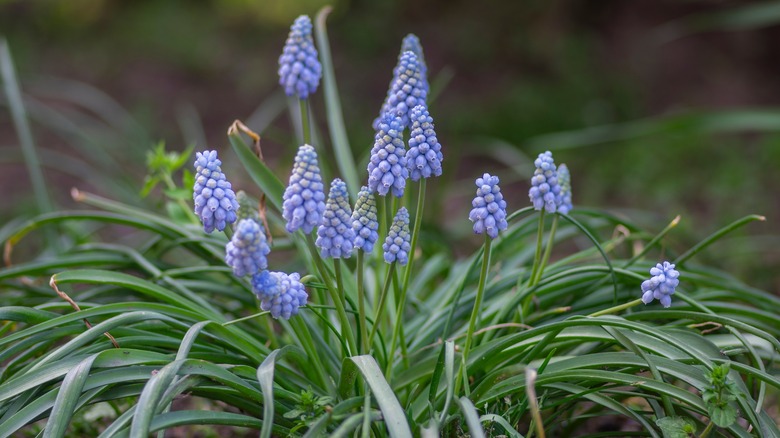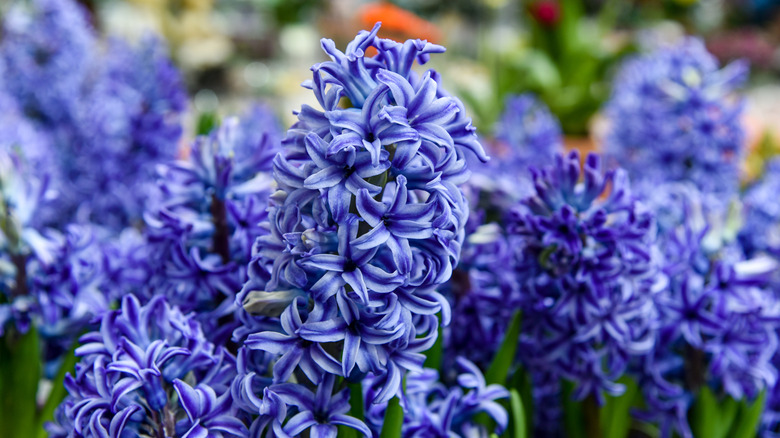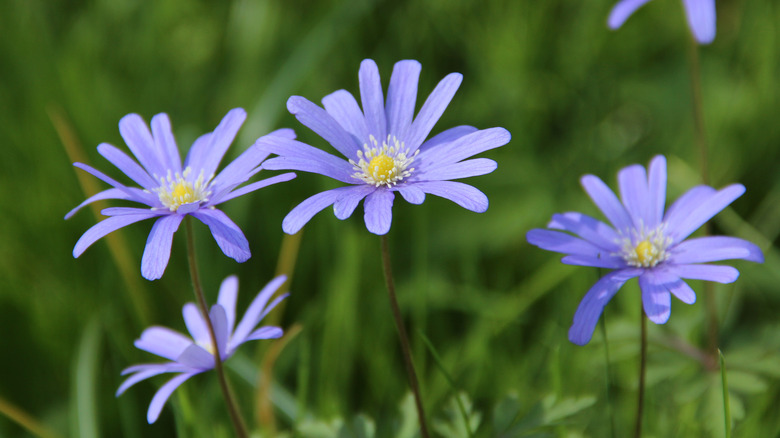Our Professional Gardener Recommends 12 Blue-Flowering Spring Bulbs To Plant This Fall
There is perhaps no sight more exciting to an avid gardener than a yard full of spring-blooming bulbs in full flower. Bulbs herald the gardening season, and their colors are a welcome sight after the long, dreary months of winter. Some gardeners enjoy mixing many colors together, while others carefully plan specific palettes of spring color when choosing their bulbs. Some of the most reliable spring bloomers come in a vast array of blue shades, suitable for many different gardens.
In general, most spring-blooming bulbs should be planted starting in mid to late autumn. Many blue flowering bulbs are fairly early bloomers, like crocuses, hyacinths, and bluebells, and can be planted near spring-blooming perennials that will start waking up just as the bulbs' foliage starts to die back. Check the bloom times before ordering or purchasing to make the most of your spring garden design plans.
Blue flowering bulbs look great with almost any other color in the spring garden. Pale blue looks especially beautiful alongside hot pink, red, or orange flowers, while darker blues look great with white, yellow, and paler pink flowers. From my experience as a professional gardener, I gathered up some of my favorite spring-flowering blue varieties, all easy to care for and reliable, to consider for your spring bulb planting.
Squill
Also known as Siberian Squill or blue scilla, squill is a popular heirloom bulb. They flower early in brilliant shades of cobalt blue. Plant them at the front of your flower bed or throughout your lawn to create a carpet of blue in early spring. The foliage dies back before lawn mowing season starts, so these early bloomers are an easy way to add color to an unexpected part of your spring landscape. Scilla increase and spread slowly over time and bloom well in partial shade.
Glory of the Snow
Glory of the Snow (Chionodoxa luciliae) are small bulbs that provide gorgeous color in early spring. The common name refers to their tendency to start blooming while there is still snow on the ground, making them a welcome sight in the early days of spring. Despite their delicate look, they're a sturdy bulb that slowly increases over time and blooms reliably. They come in shades of pale blue, white, pink, and lavender, and some gardeners like to plant the mixed colors together.
Blue grape hyacinths
Grape hyacinths are an easy-care spring-blooming bulb suitable for partial to full sun. Plant just a few bulbs, and within several years, they'll start to increase, creating large drifts of long-lasting brilliant color. Occasionally, grape hyacinths will push up some foliage in late summer or fall, and they're easily divided at this time. One of my favorites is Muscari paradoxum, a somewhat taller variety with a greenish-blue tinge to the emerging flower buds. I also love bi-color varieties like 'Ocean Magic' (pale blue and white) and Muscari latifolium (dark purple and blue).
Bluebells (English)
English bluebells (Hyacinthoides non-scripta) are often considered the quintessential English flower for their tendency to fill an entire forest with their blue-violet brilliance, making it look like something out of a fairy tale. They like a partial or dappled shade environment, a well-drained, loamy soil, and are hardy in USDA Zones 4 to 9. They sometimes take a little while to get established, but over time, they will increase in number, like other bulbs. These are not the same as Spanish bluebells, so be sure to get the right variety when purchasing.
Bluebells (Spanish)
Spanish bluebells (Hyacinthoides hispanica) look very similar to English bluebells, with slightly wider leaves and slightly paler blue flowers. They also come in white and pink shades. These bulbs are a bit more cold-hardy than English bluebells, being suitable for USDA Zones 3 to 8 and, therefore, slightly easier to grow. However, Spanish bluebells have a tendency to be invasive and will spread both from bulb division and by reseeding themselves, so keep an eye on them to make sure they don't spread too much. Fall is the best time for planting or dividing these spring-blooming bulbs.
Early Stardrift
These charming early spring bloomers have just a hint of sky blue striping on their white flowers. Also known as Russian snowdrops or striped squill, Early Stardrift (Puschkinia libanotica) blooms around the same time as snowdrops. From a distance, when planted in groups, the blooming flowers look pale blue. Plant them among your other early-blooming blue bulbs for a wonderful range of blue color. Give them a spot near the front of the border so you don't miss their lovely show in spring.
'Blue Diamond' Dutch iris
Dutch irises (Iris hollandica) bloom in mid to late spring. They have strappy, slender foliage, come in many gorgeous colors, and grow up to 2 feet tall. Unlike bearded irises, they do not spread by rhizomes. Instead, the bulbs increase and produce clumps, which can be divided and replanted in fall. There are several blue varieties of Dutch iris, including 'Sapphire Beauty,' 'Telstar,' 'Blue Ribbon,' and 'Blue Diamond,' which is a brilliant violet-blue with a bright yellow beard in the middle. Unlike bearded (German) irises, the beards are smooth and not fuzzy.
Crocus 'Blue Pearl'
Crocuses are the quintessential early spring-blooming flower, bringing glorious color as they emerge boldly through snow. Dutch crocuses have a larger flower, but species crocuses come in lovely colors, like the pale yellows of 'Cream Beauty' or 'Romance' or the pastel blue of 'Blue Pearl.' Plant them near the front of the flower bed or throughout your lawn for a shimmering carpet of delicate color. They also look great planted near early-blooming bright yellow daffodils (like 'Tete a Tete' or 'Jetfire') for dramatic color contrast.
'Alida' dwarf iris
Reticulata iris, also known as reticulated or netted iris, are dwarf irises that grow only 6 to 8 inches tall. They bloom in early spring, just after snowdrops. Unlike bearded irises and other iris types that grow from rhizomes, reticulated irises grow from bulbs. Plant them in the fall when you plant your other spring bulbs. 'Alida' is a newer variety with many shades of powder blue and yellow beards. Other blue reticulated iris cultivars include 'Cantab' and 'Harmony.' Also, look for 'Katharine Hodgkins,' a histrioides iris with pale blue brushstroke markings.
'Valerie Finnis' Muscari
Most grape hyacinths (Muscari) come in shades of medium to dark violet-blue. There are also white and even pale pink varieties available. But one pale blue cultivar has grown in popularity in recent years: 'Valerie Finnis,' named for a famous 20th-century British gardener. This lovely light blue grape hyacinth will increase each year after planting and provide a gorgeous pastel blue color in your spring flower beds. They like a well-draining soil and will bloom in partial shade conditions.
'Blue Jacket' Dutch hyacinth
Dutch hyacinths are spring favorites for their beautiful colors and intoxicating fragrance. They bloom in mid-spring and perform best in full sun. There are several blue varieties. 'Blue Jacket' has stripes of dark blue down the center of each floret. 'Delft Blue' is a pale periwinkle color. 'Peter Stuyvesant' ranges from dark purple to dark midnight blue. 'Royal Navy' has large double flowers of rich dark blue. 'Blue Ice,' also known as 'Sky Jacket,' is pale powder blue. Mid to late autumn is the best time for planting hyacinths, which need cool temperatures to flourish.
Grecian Windflower
These delicate daisy-like flowers come in shades of blue from periwinkle to sky blue, as well as white. Known as Grecian windflowers (Anemone blanda), they stand up well to the sometimes harsh weather of spring storms. The hard, nut-like bulbs are planted in the fall. In my experience, these take a little while to get established, but a year or two after planting, they bloom beautifully every spring. They look great tucked into rock garden spaces and at the front of the border.

